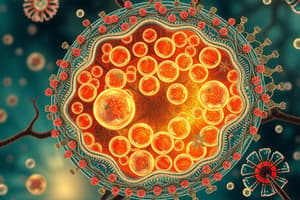Podcast
Questions and Answers
¿Cuál es la función principal de la membrana celular?
¿Cuál es la función principal de la membrana celular?
- Regular el movimiento de moléculas dentro de la célula
- Realizar la síntesis de proteínas
- Mantener la estructura de la célula
- Controlar qué entra y sale de la célula (correct)
¿Cuál es la característica principal de los fosfolípidos que componen la membrana celular?
¿Cuál es la característica principal de los fosfolípidos que componen la membrana celular?
- Son solubles en agua
- No pueden moverse en la membrana
- Tienen cabezas hidrófilas y colas hidrófobas (correct)
- Son hidrófobos en su totalidad
¿Cuál de las siguientes opciones NO es una función de la membrana celular?
¿Cuál de las siguientes opciones NO es una función de la membrana celular?
- Síntesis de proteínas (correct)
- Regulación del movimiento de moléculas
- Señalización celular
- Adhesión celular
¿Qué modelo describe la estructura de la membrana celular como dinámica y fluida?
¿Qué modelo describe la estructura de la membrana celular como dinámica y fluida?
¿Qué tipo de transporte no requiere energía?
¿Qué tipo de transporte no requiere energía?
¿Qué es la permeabilidad selectiva de la membrana celular?
¿Qué es la permeabilidad selectiva de la membrana celular?
Flashcards are hidden until you start studying
Study Notes
Cellular Theory: Cell Membrane
Structure and Function
- The cell membrane is a thin, semi-permeable membrane that surrounds the cell and regulates what enters and leaves the cell.
- Composed of a phospholipid bilayer with embedded proteins.
- Phospholipids have hydrophilic (water-loving) heads and hydrophobic (water-fearing) tails.
Fluid Mosaic Model
- The fluid mosaic model describes the cell membrane as a dynamic, fluid structure with proteins and lipids that can move laterally.
- Proteins are embedded in the phospholipid bilayer, with some spanning the membrane (transmembrane proteins) and others attached to the surface ( peripheral proteins).
Functions of the Cell Membrane
- Regulation of movement: controls what enters and leaves the cell through passive transport (diffusion, osmosis) and active transport (carrier proteins, pumps).
- Cell signaling: cell membrane receptors receive and transmit signals from outside the cell.
- Cell adhesion: cell membrane proteins help cells stick together and to the extracellular matrix.
- Cell recognition: cell membrane proteins allow cells to recognize and respond to other cells and their environment.
Selective Permeability
- The cell membrane is semi-permeable, allowing certain substances to pass through while restricting others.
- Passive transport: movement of molecules from high to low concentration without energy input.
- Active transport: movement of molecules from low to high concentration using energy input.
These notes cover the key aspects of the cell membrane, including its structure, function, and selective permeability.
Studying That Suits You
Use AI to generate personalized quizzes and flashcards to suit your learning preferences.




